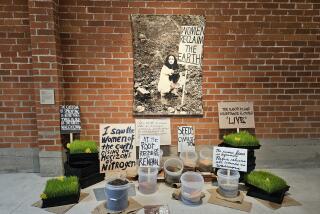ART REVIEW : The Bewitching Works of the Saars
- Share via
Strolling through “Secrets, Dialogues, Revelations: The Art of Betye and Alison Saar” is like flipping through a deck of Tarot cards. Exotic mixed-media collages whose strongest tie is with the black folk art of Africa and America, the work of Betye Saar and daughter Alison pulsates with portents of mystery, chance and destiny.
Designed to tap into the unseen forces that remain obscured by the veil of mundane daily routine, this art is about seizing the power to direct one’s fate and tuning into life’s mystical current. Perceiving the artist as a conduit to the divine, the Saars’ practice a form of benign white witchcraft with their work.
On view at UCLA’s Wight Art Gallery through Feb. 25, this beautifully installed show doubles as a retrospective survey of the work of both women and an inquiry into the relationship between mother and daughter. The mother-daughter relationship is an extremely complex one, however, and the show doesn’t delve into it as deeply as it might have. Not much is made of Alison’s struggle to move out of the shadow of her mother’s long-established career--indeed, the Saars appear to be extraordinarily copacetic co-workers.
Whereas most daughters find it necessary to differentiate themselves from their mothers, Alison has embraced her mother’s legacy with remarkable enthusiasm; like Betye, Alison takes spiritual issues as the heart of her work, favors recycled materials and vivid contrasts of color and texture, christens her pieces with poetic titles and has little interest in the formal problems of art making. Like her mother, she is more concerned with exploring the fuzzy area where romantic love overlaps with religious fervor--one of the most provocative issues raised by folk art.
The show kicks off with the entrance gallery given over to a bit of family history illustrated with photographs, text and early works by both women. We learn that Betye Saar was raised in Pasadena but spent summers with her grandmother in Watts, where she watched Simon Rodia at work on his folk art masterpiece, the Watts Towers. Clairvoyant and psychic before the sudden death of her father when she was 6, Betye also recalls watching her mother make puppets, and she grew up in an environment where art making was considered routine.
Betye’s interest in mysticism and the occult deepened with studies in phrenology, palmistry, voodoo and shamanism, and her approach to art was profoundly influenced by the haunting work of Joseph Cornell. She subsequently developed an art-making recipe that combines autobiography and spiritual symbols from around the world and centers on the resurrection of discarded materials. Betye describes her scavenging for used goods “power gathering” and believes that by recombining found objects she unleashes previously untapped powers residing within them.
Early in her career, Betye pretty much stuck to the small, highly detailed memory-box format (she referred to those pieces as “coffins and windows”), but her work eventually burst the precious confines of the box and blossomed into large sculptures and installations--the room itself has now become the container for her pieces. Recent work explores the relationship between magic and science in pieces that combine magic charms with computer chips.
Alison is the middle of Betye’s three daughters, and Betye describes has as “the stubborn one.” Raised in Laurel Canyon, Alison received much of her early art education from her father, an art conservator, and took classes from her mother at Otis Art Institute in 1970. In 1982, she had her first show, and the following year moved to New York, where her work took on a flavor distinct from that of her mother’s.
Whereas Betye’s elaborate collages are perfumed with a lyrical organic quality, Alison’s work took on a gritty, urban edge. Fashioning large, roughly hewn figures out of wood, she often pays homage to downtrodden archetypes, street people and folk heroes (a tortured figure from 1989 titled “Dying Slave” is much more to the point than anything Betye is likely to do).
Alison--who cites Joseph Bueys as an influence--also began to combine several figures to construct a narrative, and thus her work became less cryptic than that of her mother. While Alison’s approach to sculpture seems to be evolving in a classical direction (evident in the stances recent figures strike), her art is still rooted in magic. In preparation for a 1988 show in Los Angeles, she traveled to New Orleans, where she visited the grave of legendary vodun priestess Marie Laveau.
The centerpiece of the exhibition is Alison and Betye’s first collaborative work, an ambitious installation titled “House of Gris Gris.” Referring to gray magic, the piece is designed to chart the course of the soul from its mortal state to heaven and centers on a small house made of materials including moss, feathers, tin and glass.
A shrine to the promise of an afterlife, “House of Gris Gris” reprises an idea that has been with Betye from the start of her career. In a 1969 collage titled “Black Girl’s Window,” Betye positioned an image of a skeleton representing death at the center of the collage, with the explanation that “everything revolves around death.” That death must be acknowledged and integrated with life is but one of the things we learn from this fertile show.
More to Read
The biggest entertainment stories
Get our big stories about Hollywood, film, television, music, arts, culture and more right in your inbox as soon as they publish.
You may occasionally receive promotional content from the Los Angeles Times.










